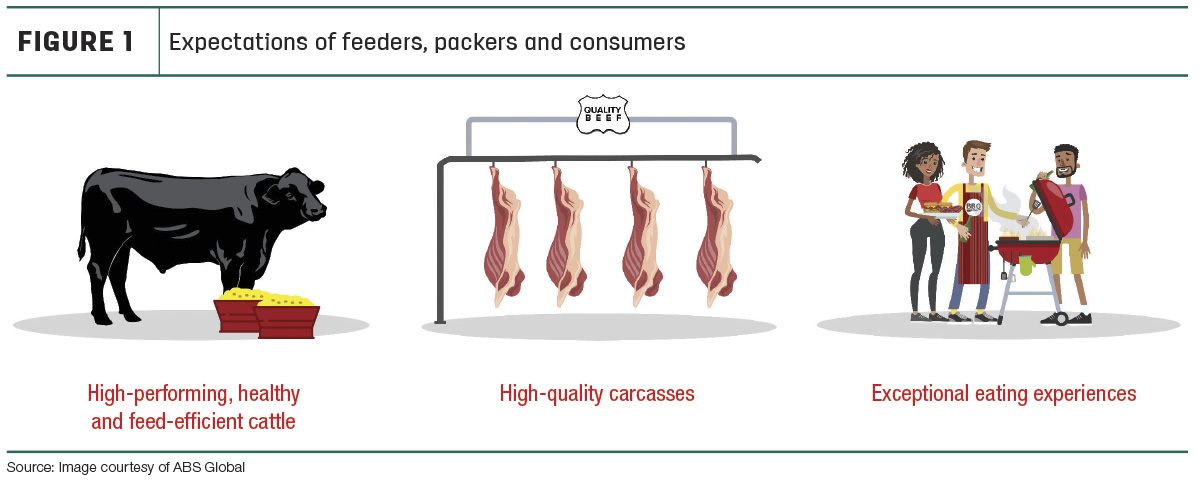More and more people are putting beef on their plates at the dinner table, which is driving up global demand for premium beef as a vital source of animal protein. Thus, the beef supply chain is looking for a consistent supply of healthy, predictable and profitable animals to fill feedyards and processors. This is not new to beef producers, as you have been creating a high-quality and safe product for decades. However, we have to ask, what has changed in the beef industry in which you operate today?
It is a simple supply-and-demand situation. As consumers increase their demand for beef protein, the supply chain will increase their demand for consistent, high-quality beef animals entering their systems. Today’s beef supply chain environment looks like this: It includes feeders who expect fast-growing, healthy cattle that convert feed to pounds of carcass weight efficiently and packers who expect as much high-quality carcass weight as they can get for every hook space in their plants. Finally, the chain concludes with consumers driving demand with their desire for an exceptional eating experience whether eating dinner out or cooking at home (see Figure 1).

The impact of beef-on-dairy in the beef supply chain
If we look back in time, the dairy industry has always been a part of the beef supply chain with cull cows and bull calves. However, the environment has shifted in recent years as more dairy producers take the opportunity to create a new profit center through beef-on-dairy. While some regions have seen more beef-on-dairy cattle produced than others, it is no secret that the Holstein dairy cow has become more valuable in the chain by producing a higher-quality product than previously.
Utilizing the right beef genetics has shown that dairy producers can create feeder cattle that will achieve upper-two-thirds Choice and Prime. This means the benchmark in quality is rising for those individuals selling their products into the beef supply chain. These animals are no longer the Holstein bull calves you were once competing against in the marketplace. The beef-on-dairy cattle have begun to demonstrate the dairy industry’s ability to vertically integrate and reduce fragmentation in the supply chain.
While those are strong statements, the intent of this discussion is to encourage you to understand your marketplace and be aware of the impact beef-on-dairy is having within the beef supply chain. It is unlikely that beef-on-dairy will ever replace native beef as the trusted, “go-to” product for quality and performance, but harnessing the power of tools, technology and genetics could mean more money in your pocket as competition increases in the marketplace.
Meat quality and yield improvements with beef-on-dairy animals
As more beef cross calves enter the beef supply chain, it has been shown that beef cross calves bring many positives to the chain from genetics to consumers. Data collected throughout the chain indicates the beef cross works well for feeder cattle, as the calves are proving to perform considerably better than their dairy contemporaries and similarly to native beef. There are a few reasons the beef-on-dairy cross works well:
- Carcass yield: Beef cross calves have been proven to have a higher red meat yield than dairy carcasses.
- Quality grade: The percentage of genetically superior beef cross calves that grade Choice or higher is similar to conventional beef animals.
- Muscle shape: Beef-on-dairy animals’ longissimus muscles are larger and rounder than Holsteins’, which improves the age-old downside of small and narrow dairy loins.
- Meat color: Traditional dairy animal carcasses have been criticized based on lean color, but beef-on-dairy crossbreeding has been shown to improve that originally dark-appearing color.
- Eating quality: Beef cross animals perform similarly to their full-blood Holstein counterparts in terms of tenderness.
Reasons the beef supply chain appreciates the beef cross
The fact of the matter is: The native beef cow herd population is at an all-time low and not expected to return to previous highs. This means cattle buyers, feeders and processors are in desperate need of continuing to fill their spaces while maximizing profitability on all feeder cattle entering their system. While performance and profitability are key, the opportunity to create a consistent supply of high-quality and traceable feeder cattle speaks volumes when it comes to high-quality beef-on-dairy calves.
- Feedlot growth: Average daily gain and feed-to-gain ratios of beef cross calves are significantly better than Holsteins and similar to conventional beef cattle.
- Consistency: Dairy animals produce a consistent supply of offspring year-round, which helps improve market stability.
- Traceability: Because of meticulous recordkeeping and the route along which beef cross calves flow through a dairy and into the beef supply chain, dairy producers have a real advantage in leading the charge for traceability.
- Sustainability: While a buzzword in the industry, beef-on-dairy calves showcase an opportunity to tell a sustainable story of productivity, efficiency and traceability.
Increase demand for your cattle
destined for the beef supply chain
You might be wondering, “Why should I care about the beef-on-dairy market?” Well, the answer does not necessarily revolve around how intertwined the dairy industry is becoming with the supply chain. It is more about considering your marketplace and if you are leveraging everything available to you to make the most out of every mating to increase profit. There is a real opportunity for beef producers to maximize profitability and not leave money on the table by using genetic strategies and technology to help their cattle stand out from beef-on-dairy competition.
Here are a few things to consider when looking to maximize terminal profitability:
- Harness the power of synchronization to shorten your calving window, increase calf uniformity, increase pounds at weaning, increase the number of days postpartum for better breedback and improve the longevity of your herd.
- Gain the genetic advantage with artificial insemination by handpicking superior sires aimed at endpoint profitability – reducing the number of natural-service sires needed.
- Consider breeding strategies to segment your herd and create the right pregnancies for heifer replacements without compromising the calf crop entering the beef supply chain.
- Use sexed semen to maximize profitability by coupling the use of female-sexed semen to make the right females and terminal sires on the rest of the calf crop or using male-sexed semen on sires focused on terminal success to make more profitable feeder cattle.
- Utilize sires with breed-leading terminal selection indexes – $Beef, $TI, TSI or other terminally focused industry indexes – if you get paid for cattle that drive beef supply chain productivity and efficiency.
Native beef remains superior in the marketplace, but the quality of cattle entering the chain has improved through genetic selection and precise mating decisions. It is imperative to be aware of your marketplace, evaluate your specific goals and take advantage of opportunities to maximize profitability. Are you leveraging the tools, technology and genetics available to you to stand out in the marketplace?







